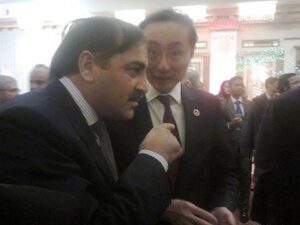By Qamar Bashir
The tectonic plates of global finance are shifting, and the tremors are already rattling the foundations of the old world order. China, once the eager buyer of U.S. Treasury bonds, has decisively turned away from financing what it now perceives as an empire in decline. This is not merely a change in investment strategy—it is a bold geopolitical maneuver. The steady offloading of U.S. debt, the pivot to real assets, and the pursuit of infrastructure diplomacy all signal that Beijing is no longer willing to play a game rigged in favor of the dollar. Instead, China is building an alternate system—one that does not revolve around the whims of Washington and the Federal Reserve.
At the height of globalization, China accumulated vast dollar reserves by running a consistent trade surplus. For years, Beijing funneled these reserves into U.S. Treasury bonds, effectively lending its savings to fund America’s debt-fueled lifestyle. As of 2025, China holds $759 billion in U.S. securities, down from over $1.3 trillion a decade earlier. The trend is unmistakable and accelerating. In just one month between November and December 2024, China slashed its holdings by $9.6 billion. Once the second-largest holder of American debt after Japan, China is now liquidating these IOUs with a clear message: enough is enough.
What has triggered this shift is not just economic prudence but strategic awakening. The U.S. has weaponized the dollar through financial sanctions, arbitrary asset freezes, and unrestricted monetary expansion. A former Federal Reserve chairman once admitted that America meets global dollar demand not through productivity or resource backing, but by simply printing money. This privilege of issuing the world’s reserve currency allowed the U.S. to import goods from across the globe without producing equivalent value—exporting paper in exchange for products. For decades, China tolerated this imbalance. But now, it has chosen to weaponize its surplus not for savings, but for strategic leverage.
Instead of buying paper promises that yield 3 percent and risk sanctions, China is pouring its reserves into tangible power. It is stockpiling copper, lithium, cobalt, oil, gas, and soybeans—commodities that can’t be frozen by a Western bank or devalued in a Wall Street crisis. These are not merely stores of value—they are instruments of economic sovereignty. Simultaneously, China has ramped up its Belt and Road Initiative (BRI), a masterstroke of infrastructure diplomacy. Through roads, ports, power grids, and telecom corridors, China exchanges capital for commodity access and geopolitical loyalty. Unlike the IMF, which offers austerity and lectures, China offers roads and development.
I recall attending a high-level academic workshop in Beijing some years ago, where a Chinese professor openly admitted: “We have so much foreign exchange reserve, we didn’t know what to do with it. So we decided to invest it in eliminating poverty at home and controlling resources abroad.” That statement, casual yet profound, encapsulated the essence of China’s pivot. Today, the results are evident. From Latin America to Africa, China is deeply embedded in infrastructure, logistics, and critical mineral extraction. It is building railways in Kenya, ports in Sri Lanka, and digital corridors across Central Asia—all bankrolled by dollars it once recycled into U.S. debt.
China is also quietly dismantling the dollar-based trade system. It has signed bilateral currency swap agreements with Russia, Iran, Pakistan, Brazil, and more. The objective is clear—not to dethrone the dollar globally overnight, but to bypass it in key trade corridors. Each swap, each RMB-denominated energy deal, chips away at dollar hegemony. In parallel, China is investing aggressively within its borders—funneling its surplus into semiconductor independence, high-speed rail networks, renewable energy grids, satellite systems, and next-generation internet infrastructure. These are not profit-driven investments; they are sovereignty-driven—designed to build strategic autonomy.
The U.S., meanwhile, remains entrapped in an illusion of infinite liquidity. With inflation on the rise and interest rates elevated, the Federal Reserve is still printing money to sustain demand and fund its staggering $35.5 trillion debt. Yet even as the U.S. issues more bonds, major buyers like China are walking away. This signals a profound crisis of confidence in the dollar system. America’s reliance on external creditors, particularly for cheap manufactured goods and critical supply chains, is its Achilles’ heel. Ironically, many of these industries were once outsourced to China. The U.S. imports not just consumer electronics and pharmaceuticals, but even core components like semiconductors and rare earths that sustain its defense and tech sectors.
If the global monetary system transitions to a multipolar reserve structure—such as that envisioned by BRICS+, which includes a potential gold-backed or commodity-backed trade currency—the consequences for the U.S. would be dire. The collapse of dollar demand would render the U.S. unable to roll over its debt at low interest rates. The cascade effect would crush its financial markets, devalue its currency, and erode its global economic standing. Already the symptoms are visible: declining global trust, rising debt-to-GDP ratio, and eroding manufacturing capacity.
Yet, the United States is still a nation of remarkable creativity, diversity, and strength. It has attracted the world’s brightest minds, offered freedom to the oppressed, and powered innovation across industries. But this dream is now imperiled by systemic fiscal irresponsibility and imperial overreach. Wars fought not in American interest but on behalf of foreign allies drain both credibility and capital. Domestic infrastructure lags behind, while digital and logistical competitiveness fall further behind China’s state-led modernization surge.
If the U.S. is to remain relevant in the post-dollar world, it must act swiftly and boldly. The first step is to stop the reckless printing of unbacked currency. Fiscal discipline must be restored. The surplus must be generated through production, not printing. America must wean itself off military misadventures and redirect its resources toward rebuilding national infrastructure—high-speed rails, smart cities, digital highways, and renewable energy. It must re-industrialize, not through nostalgia, but through strategic foresight. Above all, it must begin a global campaign of resource consolidation—not with coercion, but with cooperation.
China has read the future and is writing it in copper, fiber, and cobalt—not dollars. The world is moving toward a system based on assets, production, and connectivity—not paper promises. The U.S. still has a chance to adapt, to innovate, and to lead. But time is running out. The casino is closing. The empire must now become a republic again—one grounded in productivity, not printing presses.
About Writer:
Press Secretary to the President (Rtd)
Former Press Minister, Embassy of Pakistan to France
Former MD, SRBC | Macomb, Michigan, USA




